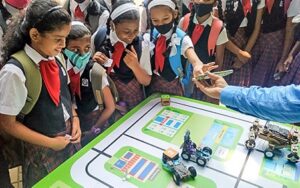WHO WE ARE
Welcome to HIPROTECH Technologies, the leading Edtech company in India. We specialize in providing comprehensive end-to-end solutions for K-12 schools, aligning with the National Education Policy (NEP) 2020.
Our mission is to equip students and teachers with 21st-century skills (STEM, Coding, Robotics, AI, ML, IOT, AR & VR) necessary to thrive in the rapidly changing innovation landscape.

WHAT WE DO
Preparing Students for rapidly changing Technological World
Innovation & 21st Century Skills
Empowering kids to become Creative Thinkers & Problem Solvers

Integrated School Solutions
End-To-End Solution for Schools aligned with NEP 2020

Practical Learning
Hands-on experience with cutting-edge technologies

HOW WE DO THIS

Coding Platform
Interactive learning with PictoBlox

Robotics Kits
Hands-on robotics education

AI Labs
Artificial Intelligence curriculum

VR Learning
Immersive educational experiences
OFFERINGS TO MAKE YOUR SCHOOL READY FOR 21ST CENTURY
PRE-TINKERING LAB
Our unique approach in our Pre-Tinkering Lab seamlessly blends education with excitement, ensuring that every child's encounter with STEAM is filled with wonder, joy, and valuable insights. With a diverse range of engaging activities and cutting-edge HIPROTECH products, we empower students to learn, experiment, and build their way to becoming confident problem solvers and critical thinkers.

ATAL TINKERING LAB
HIPROTECH offers comprehensive end-to-end assistance in establishing and running Atal Tinkering Lab in schools, providing students with a stimulating environment for exploring and mastering STEM, tinkering, the Internet of Things, and entrepreneurship.

AI & Robotics Lab for Schools
HIPROTECH AI and Robotics Lab are upgrading ICT labs in schools by integrating modern ICT, coding, AI, and robotics education into the curriculum for classes 3-12. Through hands-on learning with PictoBlox and Quarky, students are able to gain valuable skills that can help prepare them for the future.

UNLOCKING THE NEW AGE SKILLS FOR SCHOOLS & TEACHERS
20+
SCHOOLS
100K+
STUDENTS
3+
COUNTRIES
50+
TEACHERS
97%
Customer Satisfaction

Discover the power of the HIPROTECH ecosystem
A revolutionary Coding, AI, and Robotics solution for schools! Our educational specialists are here to show you how to harness the potential of this cutting-edge technology.
